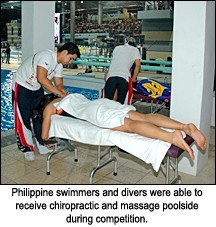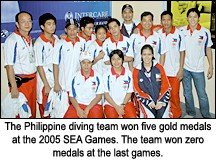The 23rd South East Asian (SEA) Games, held Nov. 27 - Dec. 3, 2005 in the Philippines, produced a bumper crop of medals for the host country's swimmers and divers. The swimming team captured four gold medals and the diving team won five gold medals, a marked improvement from the last SEA Games, in which the swimming team won only two gold medals and the diving team won zero medals.
 The 2005 SEA Games featured 11 countries and nearly 5,500 athletes. Prior to the games, the Philippine Amateur Swimming Association (PASA) forged a relationship with Intercare Healthcare Systems, a group of multidisciplinary clinics in the Philippines directed and co-owned by Martin Camara, DC, to develop a performance enhancement program that included injury prevention and treatment using conventional and alternative health care methods. The athletes were treated by two chiropractors, seven physical and massage therapists, two Graston Technique (GT) specialists and a care coordinator.
The 2005 SEA Games featured 11 countries and nearly 5,500 athletes. Prior to the games, the Philippine Amateur Swimming Association (PASA) forged a relationship with Intercare Healthcare Systems, a group of multidisciplinary clinics in the Philippines directed and co-owned by Martin Camara, DC, to develop a performance enhancement program that included injury prevention and treatment using conventional and alternative health care methods. The athletes were treated by two chiropractors, seven physical and massage therapists, two Graston Technique (GT) specialists and a care coordinator.
"It is functional health care, not just crisis management," explained Dr. Camara.
"If you align the skeletal system well, the articulation of the joints appears to perform more properly; the muscles appear more flexible, strongand free of scar tissues and restrictions. These improved findings help athletes perform any sport at a higher level. When the body is well taken care of, the skill level appears to be enhanced."
Three weeks before the SEA Games, the swimmers and divers underwent chiropractic and rehabilitative evaluations at Intercare. This included determining perceived muscle imbalances, suspected restrictions in the joints, and special needs such as chronic injuries that had not been addressed previously. The treatment sessions were tailored to suit the needs of individual athletes, in hopes of helping them enhance their performance. These treatments consisted of chiropractic adjustments to align the skeletal system; deep massage (myotherapy); GT for scar-tissue release; and acupuncture for pain relief, decongestion, and as a natural remedy for allergies in an attempt to clear up any existing sinusitis.
 During the SEA Games, Intercare set up a clinic at the Trace College Aquatics Center in Los Baños. At the clinic, which featured five treatment beds, some athletes received several treatments a day, giving them every opportunity to achieve peak performance during the competition.
During the SEA Games, Intercare set up a clinic at the Trace College Aquatics Center in Los Baños. At the clinic, which featured five treatment beds, some athletes received several treatments a day, giving them every opportunity to achieve peak performance during the competition.
In addition to the team success of the Philippine swimmers and divers, seven out of the nine divers treated by Intercare earned individual gold medals, many of them for the first time.
- Before and after Miguel Molina hit the waters at the games, his body was fastidiously treated with chiropractic adjustments, deep-tissue massage and GT. The treatments assisted in helping to heal his shoulder pain and reduce fatigue and lactic acid buildup. During the competition, Miguel won a total of five medals, three of which were gold.
- Sheila Mae Perezinsisted upon having an invigorating massage, plantar release techniques and adjustments to the bones of her foot before she would take tothe diving board. She won three gold medals.
- Zardo Domenios complained of chronic shoulder pain, but after receiving chiropractic adjustments, deep-tissue massage and GT, his pain was gone and he felt more flexible. He went on to win a gold medal and a bronze medal in diving.
- Ryan Fabrica sprained his wrist during a dive that earned him a gold medal. He was treated immediately with physical therapy and GT to control the inflammation. He managed to perform a handstand and push off from a 10-meter platform to execute a complicated dive less than 24 hours after his sprain. The dive won a silver medal for Ryan.
Additionally, swimmer Miguel Mendoza edged out his Thai competitor in the 1,500 meter relay in the last 50 meters because of his amazing endurance. Gregory Colmenares, lead coach of PASA, remarked, "The difference could be that the Thai swimmer was not treated by Intercare."
"Swimmers tend to hyperextend their back in the butterfly and freestyle strokes," commented Serry Pizarro II, a chiropractor at Intercare. "They tend to sustain lower back problems while performing both strokes. Due to the tendency to hyperextend, we adjust them into a position of flexion. Many swimmers roll their shoulders during the swimming stoke, resulting in the tendency to develop tendonosis. We adjust the clavicle and ribs, attempting to reduce these tendencies."
Mark Joseph, president of the PASA, acknowledged the benefits ofusing alternative health care methods for athletes: "This treatment is clearly making a difference in the performance level of the swimmers and divers," he said.
| Editor's note: Information for this article was provided by Martin Camara, DC. Dr. Camara, a graduate of Palmer Chiropractic College West, is the director of Intercare HealthCare Systems, maintaining multidisciplinary clinics at three locations in the Philippines: San Juan, Makati City and Alabang. As of press time, Dr. Camara is in Turino, Italy, as a chiropractic delegate to the World Olympians Association. He can be contacted by e-mail at . |
Dynamic Chiropractic editorial staff members research, investigate and write articles for the publication on an ongoing basis. To contact the Editorial Department or submit an article of your own for consideration, email
.




